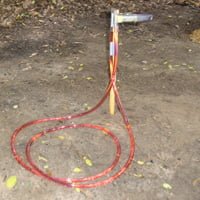What Is a High Level of Radon in Water
Water levels have been used for thousands of years. The ancient Egyptians used water levels to build the pyramids, and the Romans used them to construct their aqueducts.

A water level is easy and inexpensive to make, making it perfect for leveling a deck or shed foundation, and more accurate than a carpenter's level over long distances.
A water level can also be used around corners that are out of line of sight, something a laser or builder's level can't do.
A water level works on the principle that a liquid always seeks its own level, it doesn't matter if the body of water is a bathtub or a lake.
As long as there are no outside influences at work (such as the wind or tides), the water at one end of the body of water is the same height as the water at the other end. A water level simply substitutes a plastic tube for the body of water.
Here's how to make your own water level using nothing more than a length of flexible, plastic tubing (available by the foot at home centers in the plumbing department) and two stakes or dowels. We used 3/8″ I.D. tubing for our water, but sizes of 1/4″ I.D. or larger will work as well.

To make a water level:
- Drive a stake or dowel in the ground near the middle of the foundation.
- Attach one end of a piece of flexible tubing to the stake with the open end of the tube higher than the desired top of the foundation blocks.
- Mix a little red food coloring to tap water in a container to make it easier to see the water level.
- Hold the other end of the tube at the same height as the attached end, and fill the tube with water until it's a couple of inches below the ends of the tube. Check to make sure there are no air bubbles in the tube.
- Hold your thumb firmly over the unattached end of the tube, and move the tube over to one of the foundation blocks.
- Stand a stake or dowel vertically on top of the foundation, and hold the tube against it with both ends of the tube at about the same height.
- Release your thumb from the open end of the tube, making sure water doesn't come out of either end of the tube. Adjust the height of the tube so you have the about the same amount of tubing above the water at both ends.
- Mark the height of the water level in the tube on the stake or dowel.
- Place you thumb over the open end of the tube, and move to the next foundation block. If the foundation is level, the water in the tube will be at the same height as the mark on the stake or dowel.
- If the mark is higher than the water level in the tube, lower the block until the mark and water level align. If the mark is lower than the water level in the tube, raise the block by that amount to level the foundation.
- If at any point water spills out of the tube, refill the tube and start over on all the measurements.
You can add a water reservoir to the tube water level above by drilling a hole the same size as the tube in the top of a one-gallon jug. Drill a small second hole in the cap to even out air pressure.
Fill the jug a few inches from the top with water, insert the tube in the hole until it is not quite touching the bottom of the jug. Suck on the open end of the tube to get the siphon action started, then use as above.
What Is a High Level of Radon in Water
Source: https://todayshomeowner.com/how-to-make-a-homemade-water-level/
0 Response to "What Is a High Level of Radon in Water"
Post a Comment